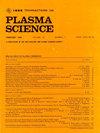森林火灾火焰条件下架空输电线路间隙击穿特性机理研究
IF 1.3
4区 物理与天体物理
Q3 PHYSICS, FLUIDS & PLASMAS
引用次数: 0
摘要
本文主要分析了火焰温度、火焰电导率和颗粒对间隙击穿特性的影响。在高温条件下,它可以迅速增加通道内的电子和离子数量,增加通道的导电性,并显著增强电极附近空气中的热解离,导致间隙击穿电压降低。由于热解离和化学电离的作用,火焰中存在大量带电粒子,使火焰电导率足够高,提供足够的电流,促进放电的发展,最终形成稳定的放电通道,导致间隙击穿。粒子进入间隙后,粒子附近的电场发生畸变。随着电压的升高,越来越多的粒子被吸引,形成粒子链来桥接更多的空隙,最终导致空隙的绝缘强度显著降低。其中,从电荷来源、火焰漏电流特性、电导率对击穿电压的影响、电导率对间隙放电的影响机理四个方面分析了火焰电导率的影响。阐述了森林火灾条件下输电线路的放电机理。根据燃气排放的相似特征和森林火灾条件下输电线路的现场统计分析数据,分析了森林火灾条件下输电线路的故障机理。首先分析了林火条件下间隙放电发展的机理,然后结合线路和林火参数,分析了林火条件下输电线路击穿模型。根据模拟试验结果(全火焰和半火焰试验数据),在火焰区杉木树枝、芦苇和稻草的平均击穿场强分别为24、55和43 kV/m;半火焰区击穿场强平均分别为155、160和150 kV/m。阐明了火焰温度、火焰导电性、灰和烟对火焰放电发展的影响机理。当森林火灾发生时,由于火焰燃烧强度高,热浮力和电场会使燃烧产生的灰颗粒浮起来,在火焰中随机悬浮,在高压电极附近触发放电,从而降低间隙的绝缘强度。灰分对间隙击穿电压的主要影响是灰分触发放电的“倍增效应”。火焰中触发放电的颗粒强度与颗粒大小和桥接间隙比例等因素有关。当火焰间隙未完全桥接时,计算220kv线路与火焰体之间的安全距离为1.83 m,这就解释了为什么秸秆、芦苇等可燃植被虽然燃烧高度未完全桥接,但仍会导致输电线路跳闸。本文提出的击穿电压预测公式可为输电线路廊道植被的管理和采伐提供一定的参考。本文章由计算机程序翻译,如有差异,请以英文原文为准。
Research on the Mechanism of Gap Breakdown Characteristics of Overhead Transmission Line Under the Condition of Forest Fire Flame
This article mainly analyzes the effects of flame temperature, flame conductivity, and particles on the gap breakdown characteristics. Under high-temperature conditions, it can quickly increase the number of electrons and ions in the channel, increase the conductivity of the channel, and significantly enhance the thermal dissociation in the air near the electrode, resulting in a decrease in the breakdown voltage of the gap. Due to the effects of thermal dissociation and chemical ionization, there are a large number of charged particles in the flame, which makes the flame conductivity sufficiently high, provides sufficient current, promotes the development of discharge, and ultimately forms a stable discharge channel, leading to gap breakdown. After particles enter the gap, the electric field near the particles undergoes distortion. As the voltage increases, more and more particles are attracted, forming particle chains to bridge more gaps, ultimately leading to a significant decrease in the insulation strength of the gaps. Among them, the influence of flame conductivity is analyzed from four aspects: the source of charge, the characteristics of flame leakage current, the influence of conductivity on breakdown voltage, and the influence mechanism of conductivity on gap discharge. The discharge mechanism of the transmission lines under the condition of forest fire is described. Based on the similar characteristics of gas discharge and the on- site statistical analysis data of transmission lines under the conditions of forest fire, the breakdown mechanism of transmission lines under the conditions of forest fire is analyzed. First, the mechanism of gap discharge development under the conditions of forest fire is analyzed, and then, the breakdown model of transmission lines under the conditions of forest fire is analyzed by combining the line and forest fire parameters, According to the simulation test results (full-flame and semiflame test data), the average breakdown field strengths of fir branches, reeds, and straw in the flame zone are 24, 55, and 43 kV/m, while the average breakdown field strengths in the semiflame zone are 155, 160, and 150 kV/m, respectively. The mechanism of the influence of flame temperature, flame conductivity, and ash and smoke on the development of discharge in flames has been clarified. When a forest fire occurs, due to the high intensity of flame combustion, the thermal buoyancy and electric field will cause the ash particles generated by the combustion to float up and randomly suspend in the flame, triggering discharge near the high-voltage electrode, thereby reducing the insulation strength of the gap. The main impact of ash on the gap breakdown voltage is the “multiplication effect” of ash-triggered discharge. The strength of particles triggering discharge in flames is related to factors such as particle size and the proportion of bridging gaps. When the gap between the flames is not fully bridged, the safe distance between the 220-kV line and the flame body is calculated to be 1.83 m, which explains why combustible vegetation, such as straw and reeds, although their combustion height is not fully bridged, still causes the transmission line to trip. The breakdown voltage prediction formula proposed in this article can provide a certain reference for the management and logging of vegetation in transmission line corridors.
求助全文
通过发布文献求助,成功后即可免费获取论文全文。
去求助
来源期刊

IEEE Transactions on Plasma Science
物理-物理:流体与等离子体
CiteScore
3.00
自引率
20.00%
发文量
538
审稿时长
3.8 months
期刊介绍:
The scope covers all aspects of the theory and application of plasma science. It includes the following areas: magnetohydrodynamics; thermionics and plasma diodes; basic plasma phenomena; gaseous electronics; microwave/plasma interaction; electron, ion, and plasma sources; space plasmas; intense electron and ion beams; laser-plasma interactions; plasma diagnostics; plasma chemistry and processing; solid-state plasmas; plasma heating; plasma for controlled fusion research; high energy density plasmas; industrial/commercial applications of plasma physics; plasma waves and instabilities; and high power microwave and submillimeter wave generation.
 求助内容:
求助内容: 应助结果提醒方式:
应助结果提醒方式:


